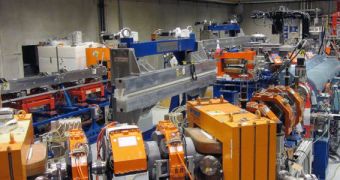Investigators from The Netherlands were recently able to compile a series of detailed three-dimensional models of certain peptides, the basic components of proteins. Their work was facilitated by the use of an advanced laser installation capable of producing far-infrared light beams.
The work was carried out by investigators at the Radboud University Nijmegen (RUN) and the Foundation for Fundamental Research on Matter (FOM), working together with scientists at the RUN FELIX (Free Electron Laser for Infrared eXperiments) installation. The latter was commissioned just last year, but it is already producing impressive scientific results.
Details of the new research were published in the February 27 online issue of the esteemed international journal Angewandte Chemie. This study is important because it contributes to improving our overall understanding of peptide structures. Additionally, such investigations have the potential to reveal even more data about other classes of small molecules.
FELIX conducts studies of molecular structures by isolating individual peptides from their surroundings and then radiating them with various frequencies of infrared light. What this does is to create a unique signature, or fingerprint, for that particular molecule.
What sets this laser installation apart from others in its class is the fact that it conducts such a study using far-infrared light, with a wavelength of up to 0.1 millimeters. This capability allowed the team to refine the structures of familiar peptides to an unprecedented level of accuracy.
“What is new about our far-infrared spectrum is that we have obtained insights in the folding of the peptides in much more detail, as well as which interactions play a role in this,” says lead researcher Anouk Rijs, who is based at the RUN Department of Biophysics as an assistant professor.
“This is important, for instance, for research into interactions between medicines and molecules in the body. Without far-infrared light it is not possible to obtain such detailed information about the molecular structure,” the investigator goes on to say, AlphaGalileo reports.
Now that the far-infrared imaging technology has been proven effective on peptides, researchers with the science group plan to move up to more complex structures and molecules, such as protein. This will be an important step forward for medicine in general.
Proteins play a critical role in nearly all diseases, yet researchers now know the structure of just a handful of these molecules. By creating a catalog of protein structures and folding mechanisms, figuring out new cures for old diseases might become easier than ever. This effort, however, needs to be complemented by new theories of what goes on at such a small scale.

 14 DAY TRIAL //
14 DAY TRIAL //